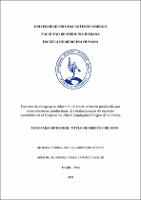Factores de riesgo para infección de tracto urinario producida por enterobacterias productoras de betalactamasas de espectro extendido en el Hospital de Alta Complejidad Virgen de la Puerta

View/
Download
(application/pdf: 131.7Kb)
(application/pdf: 131.7Kb)
Date
2019Author(s)
Larriviere Méndez, Andrea Ofelia
Metadata
Show full item recordAbstract
1. Objetivos: El objetivo del estudio fue determinar los factores de riesgo para
infección de tracto urinario (ITU) por enterobacterias productoras de
betalactamasas de espectro extendido (BLEE) en pacientes de Medicina de
Emergencia del Hospital de Alta Complejidad Virgen de la Puerta (HACVP) en
los años 2017 – 2018.
2. Material y Métodos: Fue un estudio retrospectivo de casos y controles, la fuente
de información fueron las historias clínicas de los pacientes mayores de 18 años
que consultaron al servicio de emergencia del HACVP con diagnóstico de ITU.
De ellas se seleccionaron los casos pacientes con ITU BLEE (n = 91) y los
controles ITU no BLEE (n = 182) durante los años 2017 y 2018.
3. Resultados: De los siete factores de riesgo estudiados, cinco de ellos presentaron
una diferencia estadísticamente significativa: la prostatectomía, neoplasia,
diabetes mellitus 2, uso de sonda urinaria, antibioticoterapia previa. Con estos, se
realizó un análisis multivariado donde se mantuvieron como factores de riesgo
significativos: la antibioticoterapia previa (OR= 22,52 IC = 11.4 – 44.51; p =
0.000) y neoplasia (OR = 2.87 IC = 1.19 – 6.89; p = 0.018). El 85% de las bacterias
aisladas BLEE fue Escherichia coli. El 80.2 % fue sensible a nitrofurantoína y el
100% a meropenem.
4. Conclusiones: La identificación de factores de riesgo facilita la detección
temprana y el manejo antibiótico empírico adecuado. La nitrofurantoína puede
mejorar el resultado de este sin aumentar el uso de carbapenems 1. Objectives: The objective of the present study was to determine the risk factors
for urinary tract infection (UTI) with extended-spectrum beta-lactamase (ESBL)
producing enterobacterias in Emergency patients of the Hospital de Alta
Complejidad Virgen de la Puerta (HACVP) in the years 2017-2018.
2. Material and methods: This was a retrospective case-control study, the source
of information were the medical records of adult patients older than 18 years of
age, who consulted the emergency department of the HACVP, diagnosed with
UTI during the years 2017 and 2018. The cases were: patients with ESBL UTI
(n = 91) and non-ESBL UTI controls (n = 182).
3. Results: Of the seven risk factors studied, five presented a statistically significant
difference: prostatectomy, neoplasia, diabetes mellitus 2, the use of a urinary
catheter and previous antibiotic therapy. When the multivariate analysis
performed, only the previous antibiotic therapy (OR= 22,52 IC = 11.4 – 44.51;
p = 0.000) and the diagnosis of neoplasia (OR = 2.87 IC = 1.19 – 6.89; p = 0.018)
remained as risk factors. 85% of the positive ESBL isolated bacteria was
Escherichia coli. 80.2% was sensitive to nitrofurantoin and 100% to meropenem.
4. Conclusions: Identifying risk factors facilitates early detection and empiric
antibiotic therapy. Nitrofurantoin may improve the outcome of empirical
treatment without increasing carbapenems utilization.
Subject
Collections
- Medicina Humana [2969]

